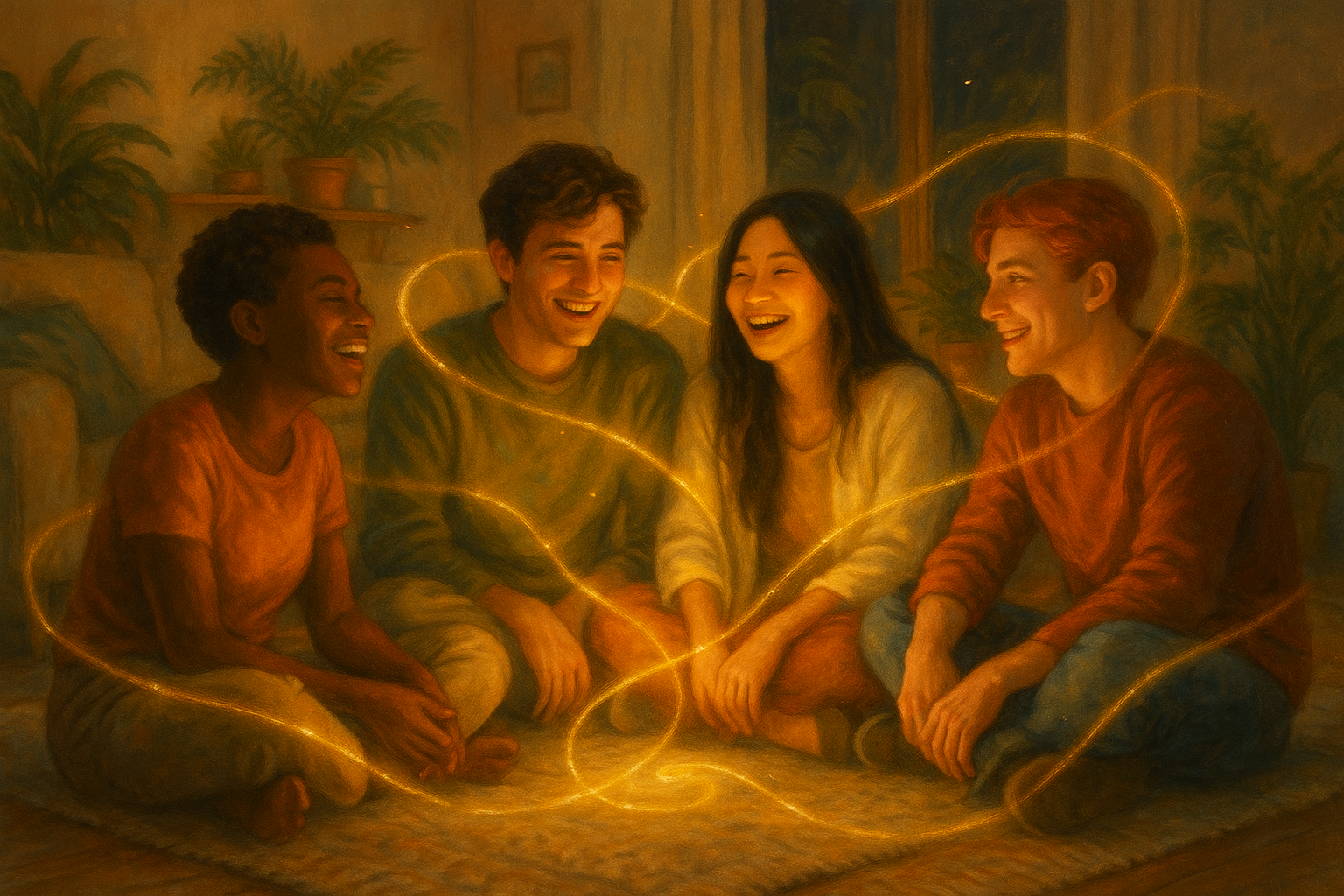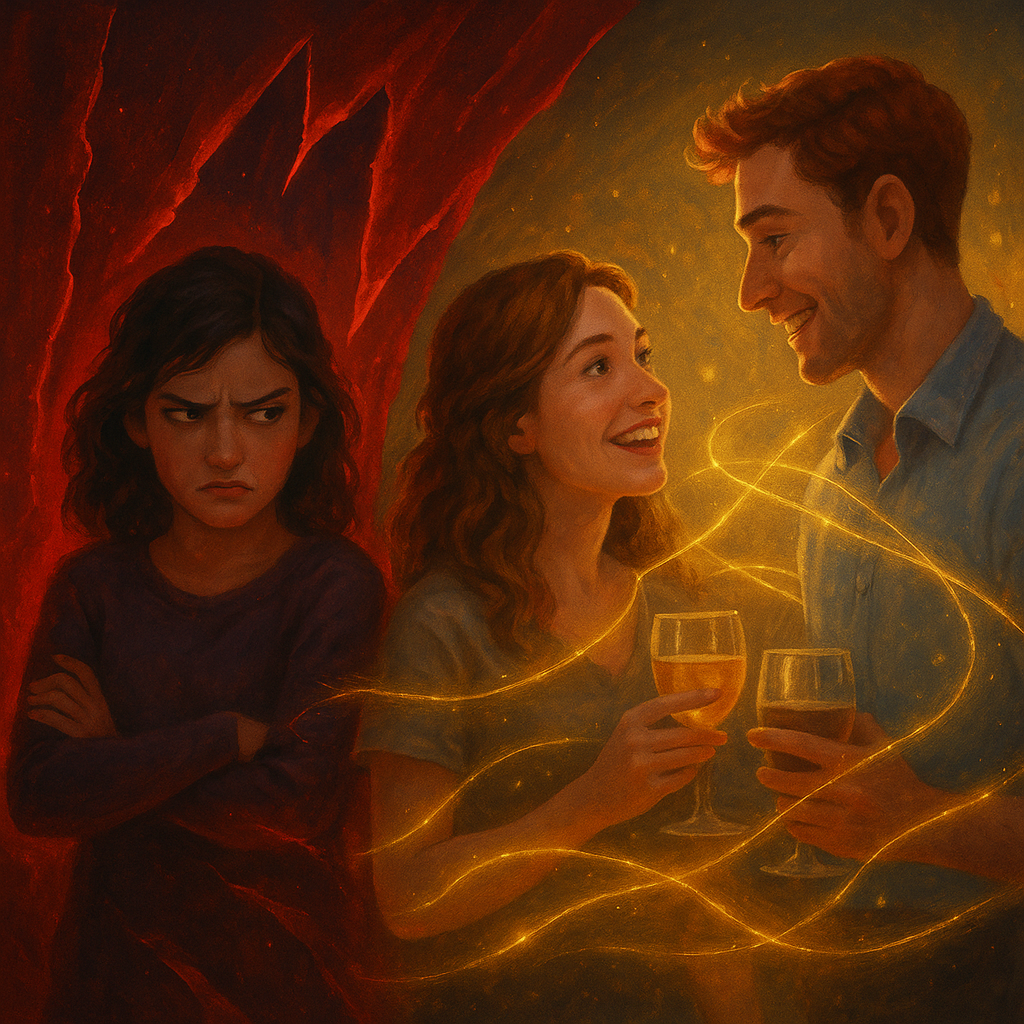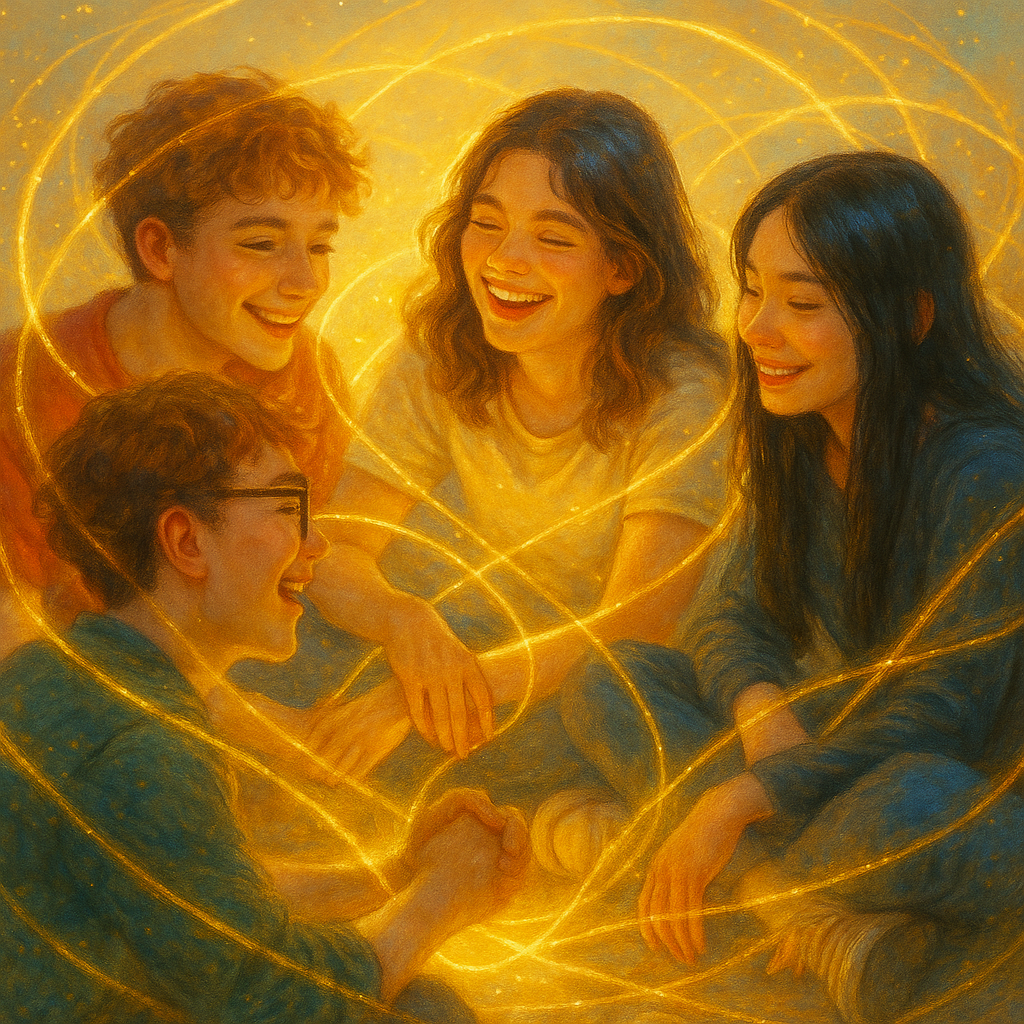Collective Effervescence and the Awkward Art of Making Friends as an Adult
⚠️ Need a heads-up? This post takes about 7 minutes to read silently (or 14 aloud)
You know that feeling.
When you’re at a concert and surrounded by thousands of strangers belting out the same lyric. And when you go wait in the line for the bathroom (for a long ass time if you’re a woman), or for a beverage and everyone is just SO friendly, chatting each other up, and acting like they are just STOKED to see you there with them.
And for a second, you’re not just you, you’re part of something buzzing, alive, electric? Sociologists have a fancy name for that: collective effervescence. Think of it like a “mob mentality” but with a more positive spin.
It’s not just about fun. It’s that deep sense of connection and belonging that reminds us we’re wired for togetherness. And yes, it can happen at a Taylor Swift show or in a football stadium, and I have to imagine this is how the pyramids were built, right?? A bunch of people all pointing the same direction, working for the same cause or feeling, but it also happens in small, everyday ways, like laughing with coworkers until your stomach hurts, or singing “Happy Birthday” with your kids.
The tricky part? As adults, especially as awkward, anxious, or neurodivergent adults, accessing that spark gets harder. Gone are the built-in playgrounds, classrooms, low-pressure workplaces, and dorm hangouts. Now it’s just… work, grocery runs, and scrolling your phone at 11 p.m. wondering why you feel so lonely.
So let’s talk about how to invite more collective effervescence into your life, even if you’re the type who cringes at small talk, gets sensory overload at parties, or just feels like friendships are harder to grow than houseplants.
What Collective Effervescence Actually Is
Émile Durkheim, a French sociologist, coined the term to describe that buzz of shared energy when people gather. Think:
Big moments: concerts, protests, spiritual services, sports games.
Small moments: board game nights, group yoga, family sing-alongs, even body-doubling on Zoom.
It matters because it:
Boosts mood and resilience.
Reminds us we belong.
Gives meaning by plugging us into something larger than ourselves.
Why It’s Harder as Adults (and Especially ND Adults)
As kids, friendship just… happened. You sat next to someone in math class, traded Pokémon cards, and suddenly, you were inseparable.
As adults:
Stress and responsibility are amplified
Everyone’s busy.
Work and family eat up time.
Friend groups are less organic.
And if you’re neurodivergent, add:
Social anxiety or awkwardness.
Sensory overwhelm in big settings.
Rejection sensitivity.
A tendency to either overshare or clam up.
So if stadium sing-alongs or sports aren’t your jam, how do you still find that spark?
ND-Friendly Ways to Tap Into Collective Effervescence
Micro-moments count. Laughing at a meme with your coworker, or even humming the same song in the car with your kid? That’s effervescence.
Go digital. Online communities, fandoms, multiplayer games, or Discord groups, yes, it’s real connection! Don’t let anyone tell you otherwise.
Choose low-sensory groups. Book clubs, crafting nights, small yoga/workout classes, or board game meetups can give you belonging without overwhelm.
Creative togetherness. Paint alongside someone, build Legos together, or join a jam session. Shared flow states are powerful.
Body doubling. The quietest form of collective effervescence, just existing next to someone else while you both get stuff done.
Practical Tips for Making Friends as an Adult
Time to get into the nitty-gritty! This is where things get awkward, but in a good way. Here’s a mix of wisdom, gleaned from Reddit threads, TikTok hacks, and real-life trial-and-error:
Upgrade the compliment game.
“I like your shirt” = conversation dead end.
“I like your shirt! Where did you get it?” = conversation starter.
Go where your interests live.
Love basketball? Hang around the court, and people will pull you in. Into D&D (or want to be)? Head to a hobby shop on game night. Go to an open mic night just to watch, especially if you’re the type who loves to hand out compliments! Enthusiasts are thrilled to talk about their thing.
Remember: the most popular people are the ones who like the most people.
Not the coolest, not the most polished, just the most genuinely curious.
Think “friendship boxes,” not “soulmate bestie.”
Adulthood is a mix of football friends, mom-friends, work friends, childhood friends you only catch up with once a year. All valid. Not every one needs to be your bestie, what “box” do they fit in?
Practice your face.
Yep. RBF is real. Look away, relax your face, then look back in the mirror. Would you want to talk to that person? Adjust as needed. (I fully understand, as a late-diagnosed AuDHD person, that many of us have spent a lot of time masking; this isn’t about putting on “fake” so much as putting on “approachable”.)
Listen first, relate later.
ND folks often jump in with our own stories (we call it relating, NTs call it one-upping or interrupting). Try mentally “tapping” your story to hold it until they finish. Then connect by asking: “How did you handle that part?”
Mirror, but make it subtle.
Match tone, volume, and body language just a notch. It signals safety and connection without feeling like a parody. (many of us ND people already unconsciously do this!)
Let extroverts adopt you.
Try saying, “I admire how you command the room. I’m a little shy.” Extroverts love pulling quieter folks into the circle.
Use names.
Repeat someone’s name after they introduce themselves. Saves you from that mid-chat panic when your brain blanks.
Pay it forward.
Already comfortable in a group? Seek out wallflowers. Or bring a killer dessert to share. Food is the ultimate icebreaker.
Reddit wisdom:
“Remember that everyone is a human being. We all have likes, dislikes, problems, and fears. They are made of flesh and bone. Just like you.”
TikTok-Inspired Tricks for Confidence in Social Spaces
I came across a TikTok (creator: @spiritualphilo) with some quirky but surprisingly effective confidence hacks:
Predatory Stillness: Nervous? Instead of fidgeting, try absolute stillness. It radiates quiet confidence.
Stranger’s Eye Game: Hold someone’s gaze just a second longer than usual. That micro-moment feels electric.
Invisible Audience Trick: Pretend you’re in a documentary, your posture and aura shift instantly.
Silent Countdown: Before speaking or walking into a room, pause, and count down, 3-2-1. It gives you a moment to prime yourself.
Animal Embodiment: Channel an animal you admire, lion, panther, hawk, whatever, and walk as if carrying its spirit.
Predator Gaze Training: Practice holding eye contact with yourself in the mirror to rewire how you carry your stare.
Are these a little dramatic? Maybe. But they’re also playful ways to experiment with presence, especially for ND folks who often feel invisible or unsure how to “take up space.”
Red Flags to Be On the Lookout For (In Others… aND Yourself)
Friendship isn’t just about finding the spark. It’s also about spotting smoke before there’s fire. Some red flags are obvious, others are subtle, and a few can sneak up on us. Here’s what to watch for in other people, and if you’re honest, a few things to check in yourself too.
The Too-Much, Too-Fast Crew
Trauma dumping on day one. Vulnerability is beautiful, but if someone unloads their entire life story before you’ve finished your iced coffee, that’s a sign of shaky boundaries. (Check yourself here too, save the heavy stuff until trust builds.)
Like bombing. That person at a new job who attaches themselves to you instantly, while everyone else seems wary? Sometimes it’s an ND quirk, but often it means they’ve burned bridges and you’re “fresh meat.”
The User Vibes
“Friendly” → immediate request. If they reach out, act warm, and then drop “Can you help me move this weekend?” watch for strings attached.
Only around when they need something. Whether it’s venting, favors, or filling empty time slots, real friendship goes both ways.
The collector. Think Professor Slughorn from Harry Potter. If you feel like you’re being added to someone’s “set piece” collection (gay best friend, quirky ND friend, therapy-friend), you’re not a person to them, you’re an accessory.
The Personality Hijackers
Always the victim. Even when they’re clearly in the wrong. (Psych folks call this “egosyntonic”; they can’t even see their own faults.)
All about me. If they never ask you anything and only monologue, that’s not a conversation, it’s a podcast you didn’t subscribe to.
One-uppers. Every story you share? They’ve done it bigger, better, faster, more impressive. Exhausting.
Shit-stirrers. This is my mom’s word for people who live to sow drama and chaos. If they treat everyone else poorly but you so nicely, don’t be fooled; it’s just not your turn yet.
The Control + Chaos Types
Possessive jealousy. If they bristle at you having other friends, that’s control, not loyalty.
Making all the plans, all the time. If they can’t compromise or take suggestions, it’s not a friendship, it’s a dictatorship.
Ghosting with excuses. Flakiness happens, but if every hangout depends only on their mood, without real effort? Red flag.
Consistent lies or embellishments. Even little ones erode trust over time.
The Social Green Lights (Hidden Red Flags)
Negative commentary on everyone. If they’re constantly running a mean girl track about strangers, it’s only a matter of time before it’s your turn. And even if it never turns on you, it’s still a bummer and sucks the air out of the room.
Mocking your interests. Friends don’t make you feel dumb for loving D&D, K-pop, monster romance stories, or your plant collection.
Public call-outs. Joking at your expense, sharing your business without permission, or putting you down as entertainment = not the fuckin vibe.
Service-staff test. Watch how they treat waiters, cashiers, Uber drivers. If kindness is selective, so is their respect for you.
And a Few More Fun Ones
Personality = disorder. If someone makes their diagnosis, trauma, or issues their entire identity, it can feel like there’s no room for anything else.
People who hate animals. Okay, not always a dealbreaker, (some folks have trauma there, or just allergies, of course) but if my dog doesn’t like you… We have problems.
People you constantly feel like you need to rescue. Being the unpaid therapist to people can wear you down (just send them my number instead, :::wink wink:::).
Wrapping it Up: The Spark Is Out There
Collective effervescence isn’t reserved for stadiums or megachurches. It’s in laughter, eye contact, creative flow, shared meals, quiet co-working, and yes, even TikTok trends.
Making friends as an adult is awkward, but you don’t need one “best friend” or a giant crew to feel connected. You just need a few sparks, a few moments of effervescence, and the courage to show up where your interests are.
So here’s your homework:
This week, try one thing, extend a compliment into a question, show up somewhere your hobby lives, or even just practice your “approachable face” in the mirror. Small steps add up.
Because the truth is: you don’t have to just chase belonging in the loudest room, you can create it in the smallest one.






